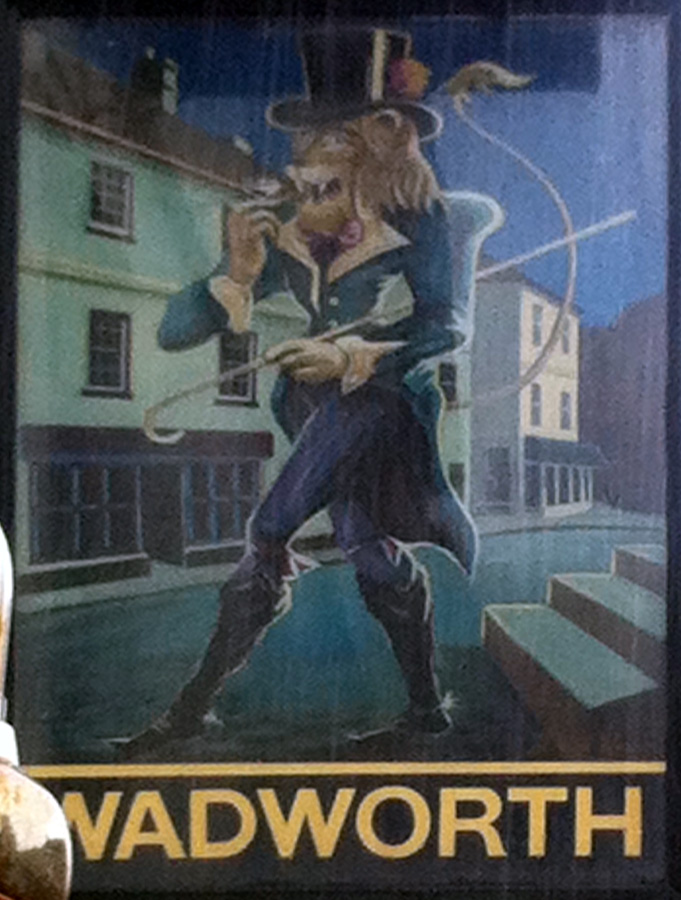 |
| Clare at Farleigh Castle |
 |
| Farleigh Castle |
 |
| Clare in St. Thomas Moore Catholic Church, Bradford on Avon |
 |
| The bridge over the Avon in the centre of town |
 |
| St. Margaret's Stairs featuring the author, distracted |
 |
| The author at the footbridge over the Avon |
What did we do in Bradford on Afon? After parking at the railway station we meandered into town, walked the fifty yards of The Shambles (the old medieval market) and ended up next door in the Dandy Lion (think about it) pub.
 |
| The Dandy Lion pub |
We then crossed the road and saw the Catholic Church, the former Town Hall, and stepped inside. Next we ambled on down to the river where we crossed at the footbridge and considered what to do next: walk by the riverside or visit the museum? We decided on the latter and strolled the few hundred yards to its probable location where we failed to find it. We popped into the library to ask and were told it was actually upstairs. Sadly, due to a shortage of volunteers it was closed.
Back across the road and we were at the tea house next to the Tourist Information shed (yes, it was no more than a shed). Two Americanos, a relax in the sun and it was back to the car - just under two hours.
--
Did you run SETI@home on your computer in the old days? Made a very nice screen-saver as well as doing good, back when we believed in aliens beaming out radio signals. Then they moved it onto BOINC, a general purpose platform, and it got really hard to install and manage, so I abandoned. The years went by.
Today I decided: why not? Do some good: not with SETI@home but with some of the other volunteer-computing projects, you know, protein-folding, analyzing CERN-LHC results and that kind of stuff. So I got myself into the process and found that these days it's not just BOINC you download but a virtual machine box as well (I won't bore you with why).
I did all those things - took a while - and finally I was in the BOINC/BAM project management website environment and had opened an account. And again, it's as hard to manage as ever. I have no idea what all those projects actually do (there are quite a few now) and it doesn't seem at all easy to subscribe to them. Let's just say I tried but nothing much seemed to happen.
I'm sure if I invested a day of my time I could get on top of the offerings and figure out how to download and run the projects of my choice, but .. why is the entry bar so very high? Most people will just back off and bin this whole thing in the 'too difficult' bag.
So many potentially useful sites are ruined by completely neglecting user-interface design and the nature of the user experience. It's a kind of design-autism.
Update: (Aug 2nd): Just to add insult to injury, the Oracle VirtualBox download stopped my Epson printer working. It's now been uninstalled, along with BOINC. Shame.
---
Yesterday I completed lecture 6 of Professor Susskind's General Relativity course. He was talking about photon orbits around a Schwarzschild black hole and the experience of a falling into a black hole past the event horizon: the infaller gives a very different account to that of an observer remote from the event horizon.
This is an advanced undergraduate class at Stanford University so the mathematics Susskind deployed included generalized coordinates, the Lagrangian formulation of classical mechanics, multivariate calculus and he already covered the basics of differential geometry and tensors. Yet every mountain you climb in physics is just a foothill to a higher range of apparently inaccessible peaks. Susskind gave an incredibly hand-wavy account of the maths underpinning the two observers' very differing observations (one infalling, the other stationary but remote) by looking at hyperbolic coordinates and a transform into the curved spacetime of the Schwarzschild metric.
We haven't got anywhere near the field equations yet.